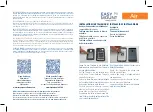
- 22 -
•
If the low ambient condition kit is used, turn off the compressor before
power the condensing unit. Only turn on the compressor after the
condensing unit has been powered for 12 hours.
1) Evacuate the system; both discharge and suction valves must be in the
middle positions during evacuating.
2) Charge the system through both suction and discharge valves with refrigerant
using the suggested amount; both discharge and suction valves must be in
the middle positions during charging.
3) Connect the power to start the system and check the following temperatures
and pressures.
9. Adjusting and Completing the Installation
1) It may use a fan speed control to adjust the air flow to achieve the specified
CFM. The fan will run from the minimum speed to full speed with the control
knob at the lowest and highest speed position.
To
adjust the minimum speed,
turn control knob to the lowest speed position, then rotate the setting (located
on the side or front) clockwise to decrease the minimum speed or counter-
clockwise to increase the minimum speed. The minimum speed should be
adjusted until it supplies the required CFM.
Fig. 14 Fan Speed Control
2) The subcooling at the condensing unit shall be around 10°F. The charge may
be complete when there are no more bubbles forming in the liquid indicator.
3) Head pressure range: 125 ~ 150 psig at 70 ~ 90 °F condensing unit ambient
temperature.
4) The evaporator’s constant pressure expansion valve is set around 30 ~ 35
psig (35 ~ 40°F) at factory. This pressure setting gives a dew point to
maintain the proper humidity for storing wine.
5) The temperature split across the evaporator shall be 8 ~ 10°F at 55°F wine
cellar temperature.
6) Again, you must verify if the superheat at the evaporator unit is around 9 ~
18°F at 55 °F wine cellar temperature under high ~ low ambient temperatures.
7) If the superheat is high, check the subcooling first to know if the refrigerant
charge is sufficient. If the charge is not sufficient, add more refrigerant. If the









































